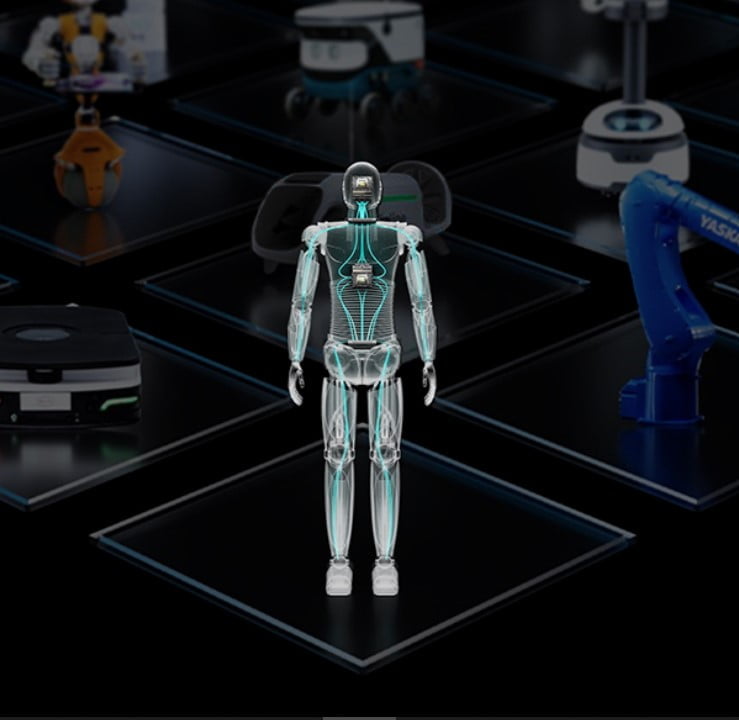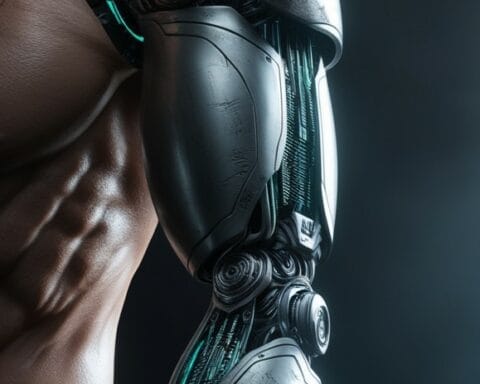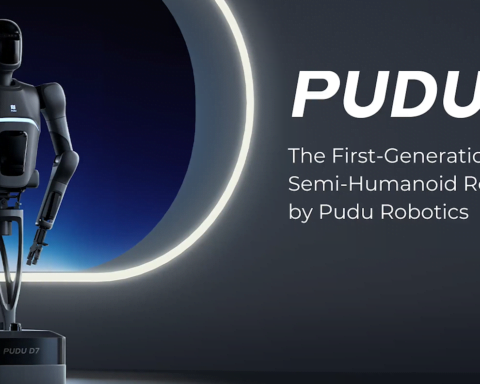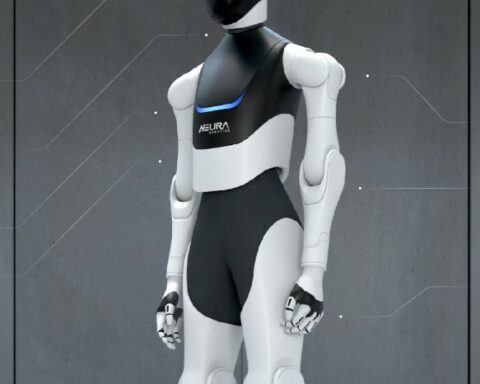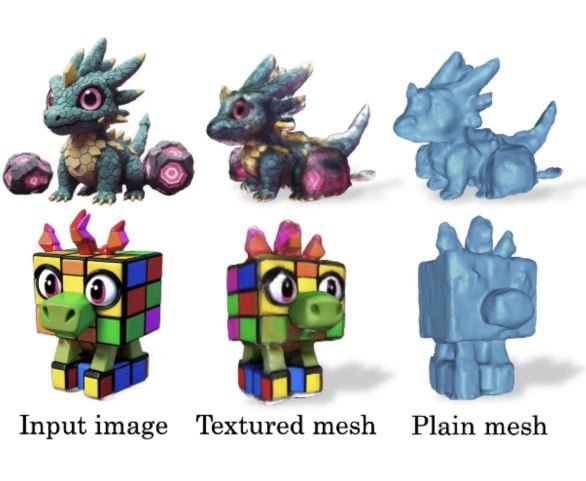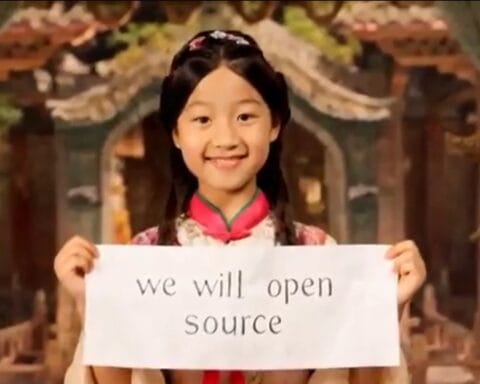Last Updated on March 19, 2024 1:08 pm by Laszlo Szabo / NowadAIs | Published on March 19, 2024 by Laszlo Szabo / NowadAIs
Nvidia’s Project GR00T: Human Robots Are Closer Than You Think – Key Notes
- Nvidia’s Project Gr00t aims to develop foundation models for humanoid robots.
- The project leverages multimodal AI to enable robots to understand and perform tasks from various inputs.
- Gr00t stands for Generalist Robot 00 Technology, focusing on versatility in robotic skills.
- Collaboration with leading humanoid robot companies to enhance robotics development.
- Utilizes Nvidia’s Isaac Robotics Platform for simulation, development, and deployment of AI-powered robots.
- Isaac Manipulator and Isaac Perceptor enhance robotic dexterity and environmental navigation.
Introduction
Humanoid robots have long been a fascination, pushing the boundaries of artificial intelligence (AI) and robotics. These advanced machines, capable of emulating human movements and interacting with the real world, hold immense potential for revolutionizing various industries. Nvidia, a leading hardware company in AI, is making a contribution to the field of robotics with its latest project, GR00T.
The Significance of Project GR00T
Building Foundation Models for Humanoid Robots
Nvidia CEO Jensen Huang aptly describes the development of foundation models for general humanoid robots as one of the most exciting challenges in AI today. The concept of humanoid robots has attracted serious attention, both in terms of venture capital investment and skepticism. Nvidia recognizes the importance of this form factor and aims to contribute to the advancement of humanoid robotics through initiatives like Project GR00T.
Nvidia’s Commitment to Robotic Innovation
As a leader in AI hardware, Nvidia has established itself as a driving force behind robotic innovation. The company’s Isaac and Jetson initiatives have demonstrated its dedication to pushing the boundaries of what robots can achieve. With Project GR00T, Nvidia aims to solidify its position in the humanoid robot race. By collaborating with prominent humanoid robot companies, Nvidia is set to shape the future of robotics.
Understanding Project GR00T
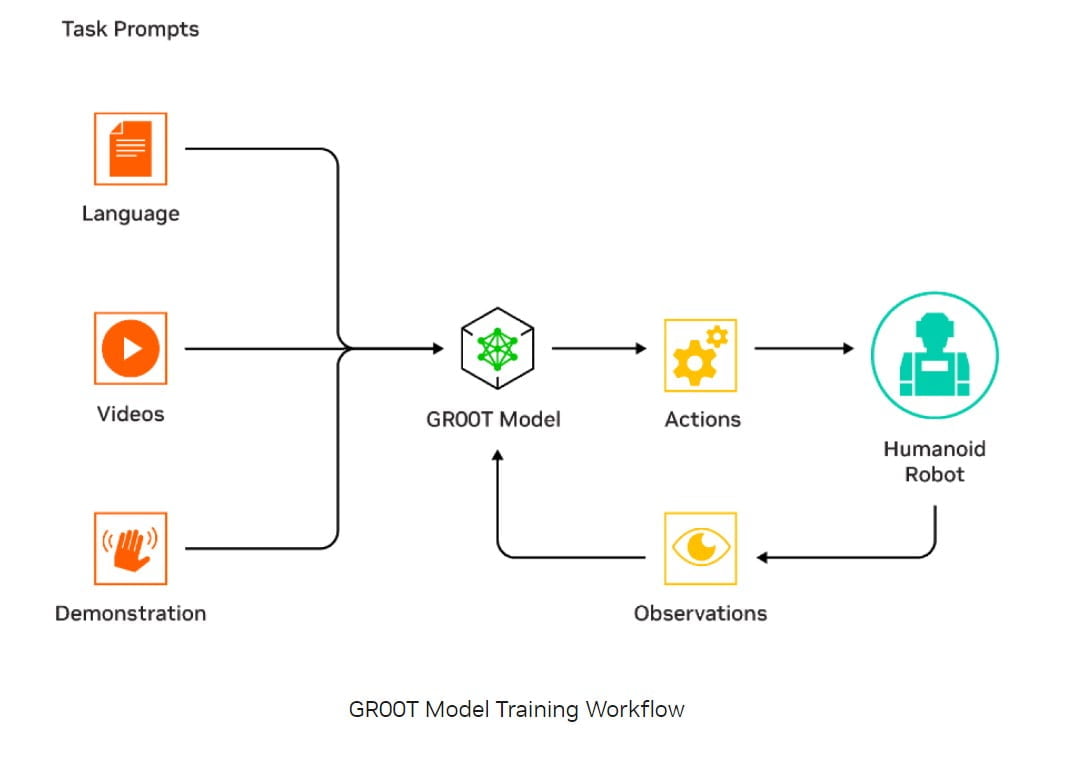
The Multimodal AI Approach
Project GR00T leverages a multimodal AI approach to empower humanoid robots. The system takes inputs in the form of text, speech, videos, or live demonstrations and processes them to generate specific actions. By understanding natural language and emulating human movements, GR00T enables humanoid robots to navigate, adapt, and interact with the real world effectively.
The Power of Generalist Robot Technology
GR00T, which stands for Generalist Robot 00 Technology, serves as the foundation model for humanoid robots. It equips these robots with the ability to learn a wide range of skills and solve diverse tasks. By combining the latest advancements in generative AI and transformers, GR00T acts as the mind of robots, driving them toward artificial general robotics.
Expanding the Capabilities of Humanoid Robots
Emulating Human Movements through AI
One of the key objectives of Project GR00T is to enable humanoid robots to emulate human movements. By observing and learning from human actions, these robots quickly acquire coordination, dexterity, and other essential skills. Nvidia CEO Jensen Huang showcased this capability during the GTC keynote, where multiple GR00T-powered humanoid robots successfully completed various tasks.
Navigating, Adapting, and Interacting with the Real World
GR00T empowers humanoid robots to navigate unstructured environments, adapt to changing circumstances, and interact with the real world. With the ability to process multimodal instructions and past interactions, these robots can execute actions that enable them to solve a variety of tasks. This opens up new possibilities for integrating humanoid robots into everyday life.
Collaboration with Leading Humanoid Robot Companies
Partnering for Future Robotics Advancements
Nvidia recognizes the importance of collaboration in driving advancements in the field of humanoid robotics. Project GR00T has garnered the support and partnership of numerous leading humanoid robot companies. By working together, Nvidia and these companies aim to accelerate the development and deployment of humanoid robots, bringing them closer to becoming a part of daily life.
Prominent Humanoid Robot Companies on Board
Nvidia’s comprehensive AI platform for humanoid robots has attracted partnerships with renowned companies such as 1X Technologies, Agility Robotics, Apptronik, Boston Dynamics, Figure AI, Fourier Intelligence, Sanctuary AI, Unitree Robotics, and XPENG Robotics. These collaborations ensure that the development of humanoid robots is not limited to isolated efforts but benefits from a shared ecosystem of expertise and resources.
The Role of Isaac Robotics Platform
Developing, Simulating, and Deploying AI-Powered Robots
Nvidia’s Isaac Robotics Platform plays a main role in the development, simulation, and deployment of AI-powered robots. The platform provides developers with an end-to-end solution for building robotic systems. With tools like Isaac Lab and OSMO, developers can train and test their models in a GPU-accelerated virtual environment, manage training and simulation workloads, and streamline the deployment of AI-powered robots.
Leveraging Isaac Lab and OSMO for Project GR00T
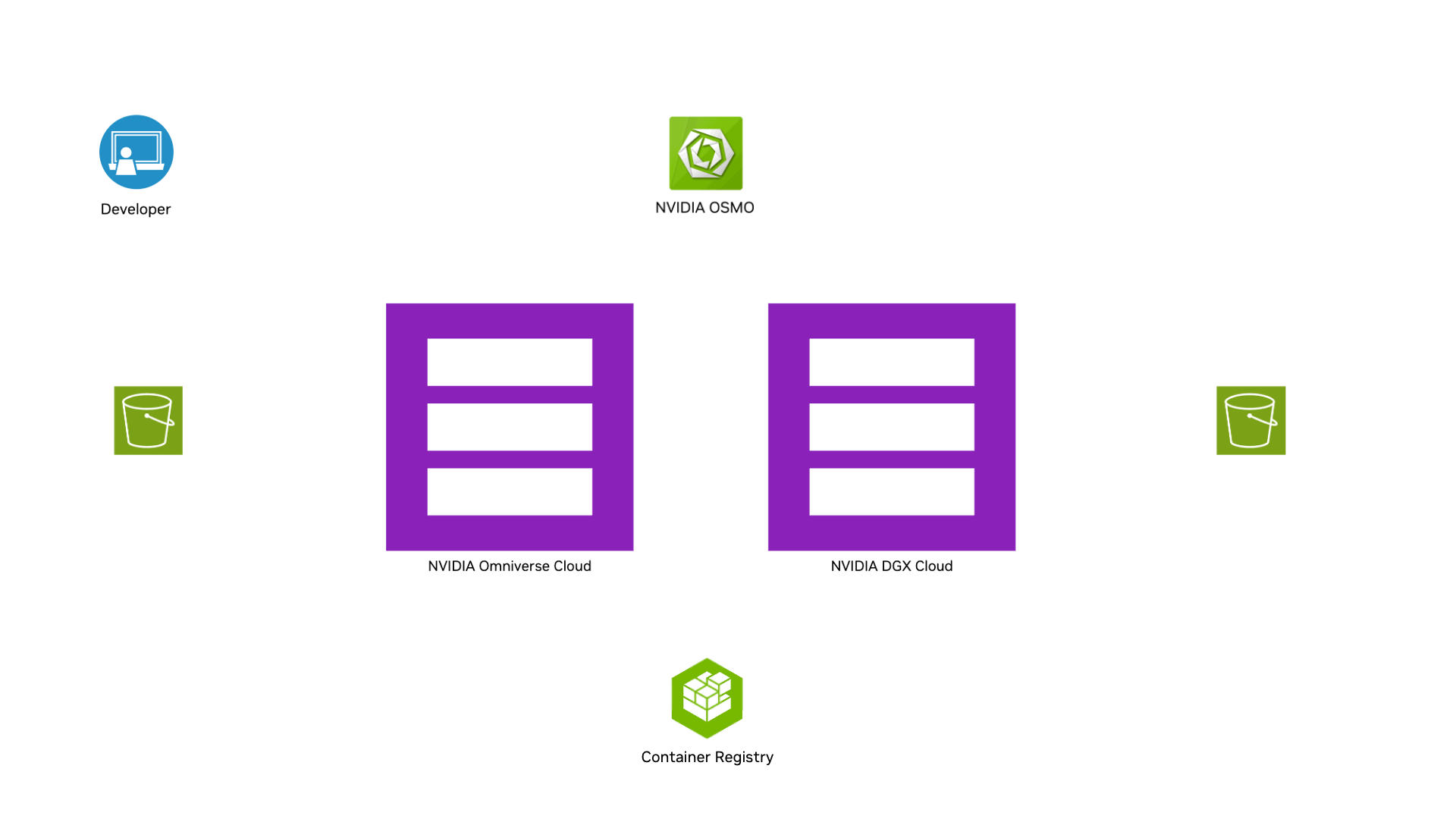
Isaac Lab, a lightweight reference application built on the Isaac Sim platform, is specifically optimized for robot learning. It supports reinforcement, imitation, and transfer learning, making it an essential tool for training the GR00T model. OSMO, the compute orchestration service, coordinates training and simulation workflows across Nvidia DGX systems, Nvidia OVX systems, and hardware-in-the-loop validation systems, ensuring efficient and scalable development of AI-powered robots.
Isaac Manipulator in Project Gr00t: Enhancing Robotic Arm Capabilities
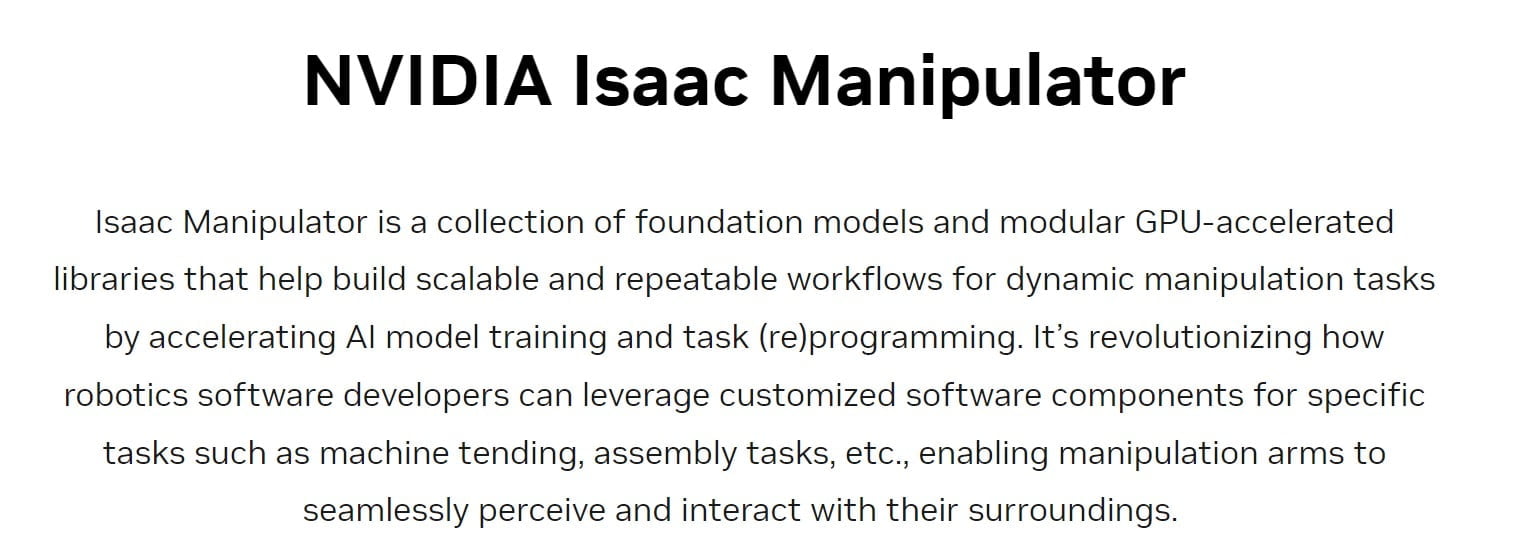
State-of-the-Art Dexterity and Modular AI Capabilities
In addition to Project GR00T, Nvidia’s Isaac Robotics Platform offers Isaac Manipulator, a set of tools and models dedicated to improving the capabilities of robotic arms. Isaac Manipulator includes state-of-the-art dexterity and modular AI capabilities, enabling robotic arms to perform complex tasks with ease. With GPU-accelerated libraries and foundation models, developers can enhance motion planning, perception, and path optimization, automating a broader range of robotic tasks.
Improving Motion and Grasping with Isaac Manipulator
Isaac Manipulator empowers robotic arms with advanced capabilities, such as object detection, 6D pose estimation, tracking, and dense predictions for grasping. These tools significantly improve motion planning and increase efficiency and throughput. Partnering with companies like Franka Robotics, PickNik Robotics, READY Robotics, Solomon, Universal Robots, and Yaskawa, Nvidia is driving innovation in the field of robotic arms.
Isaac Perceptor in Project GR00T: Guiding Robots in Unstructured Environments
3D Perception and Surround Vision Capabilities
Isaac Perceptor, another offering from Nvidia’s Isaac Robotics Platform, focuses on enabling robots to navigate unstructured environments. By leveraging AI-based accelerated algorithms, Isaac Perceptor offers multi-camera, 360-degree vision capabilities. This technology enhances perception and guides robots through complex surroundings, enabling them to detect obstacles, perform mapping, and achieve semantic-aware navigation.
Advancing Autonomous Mobile Robot Functions
Isaac Perceptor is particularly valuable in advancing the functions of autonomous mobile robots (AMRs) in manufacturing and fulfillment operations. By integrating the platform into AMRs, companies like ArcBest, BYD, and KION Group can improve perception, semantic-aware navigation, and 3D mapping. This results in enhanced performance, increased efficiency, and improved safety in material handling processes.
The Promising Future of Project GR00T
Democratizing Access to AI-Powered Humanoid Robots
Project GR00T represents a significant step toward democratizing access to AI-powered humanoid robots. By developing a general-purpose foundation model and collaborating with leading humanoid robot companies, Nvidia aims to make these advanced machines more accessible and applicable in various industries. The combination of GR00T’s capabilities and Nvidia’s dedicated computing platform opens up new possibilities for integrating humanoid robots into daily life.
Embracing the Potential of Embodied AI
Embodied AI, the fusion of AI and robotics, holds immense potential for addressing humanity’s challenges and driving innovation. Nvidia’s Project GR00T, along with other initiatives in the field, is at the forefront of this technological revolution. By prioritizing long-term partnerships and leveraging the expertise of leading companies, Nvidia is poised to shape the future of humanoid robotics and unlock innovations that were previously beyond our reach or imagination.
Conclusion
Project GR00T marks a significant milestone in the field of humanoid robotics. Nvidia’s multimodal AI approach, combined with its partnerships and dedicated computing platform, sets the stage for groundbreaking advancements in the capabilities and accessibility of humanoid robots. As the world moves toward artificial general robotics, Project GR00T paves the way for a future where humanoid robots play an integral role in various industries and everyday life.
Definitions
- Project Gr00t: A Nvidia-led initiative to create generalist foundation models for humanoid robots, aiming to equip them with a wide range of skills for diverse tasks.
- Nvidia: A global leader in AI and graphics processing technology, driving innovation in robotics and AI through hardware and software solutions.
- 3D Perception: The capability of robots to understand their environment in three dimensions, enabling navigation, object recognition, and interaction with the world.
- Autonomous Mobile Robots (AMRs): Robots that can move and operate independently in various environments, performing tasks such as delivery, transportation, and surveillance without human intervention.
- Generalist Robot: A robot designed with the versatility to learn and perform a wide variety of tasks, as opposed to being specialized in a single function.
- Foundation Robot Models: Core AI models that provide robots with basic understanding and capabilities, allowing them to learn and adapt to perform a broader range of tasks.
Frequently Asked Questions
- What exactly is Project Gr00t, and why is it significant?
- Project Gr00t is an ambitious initiative by Nvidia aimed at pioneering the development of generalist robots, or robots that can perform a wide range of tasks, rather than being limited to specific functions. The project’s significance lies in its potential to dramatically enhance the versatility and adaptability of humanoid robots, making them more capable of handling the complexities of real-world applications. By integrating advanced AI models and multimodal learning capabilities, Project Gr00t seeks to empower robots with a deeper understanding and an ability to learn from diverse inputs such as text, speech, and visual cues, thereby pushing the boundaries of what robots can achieve and how they can be integrated into various aspects of daily life and work.
- In what ways does Project Gr00t differ from other robotics projects, and what are its unique contributions to the field?
- Project Gr00t distinguishes itself from other robotics projects through its focus on creating foundation models for humanoid robots that can learn and perform a multitude of tasks across different environments. This generalist approach contrasts with the more common practice of developing robots specialized for specific tasks. The project’s unique contribution lies in its comprehensive application of multimodal AI, which allows robots to process and learn from various forms of input, including text, speech, video, and live demonstrations. Furthermore, Project Gr00t’s collaboration with leading robotics companies ensures that the project benefits from a wealth of expertise and resources, accelerating innovation and the practical application of humanoid robots in industries, healthcare, service sectors, and beyond.
- Who is leading the development of Project Gr00t, and which organizations are involved?
- Nvidia, a leader in AI and computing technology, is at the forefront of Project Gr00t’s development. Nvidia’s extensive experience in AI hardware and software places it in an ideal position to drive advances in robotic capabilities. The project involves collaboration with a range of leading humanoid robot companies, including well-known names like Boston Dynamics, Agility Robotics, and many others. These partnerships are critical for combining Nvidia’s AI and computing expertise with the robotic design and engineering know-how of these companies, creating a powerful synergy that fuels innovation and the expansion of robotic capabilities.
- What are the main components and technologies involved in Project Gr00t, and how do they work together to advance humanoid robotics?
- The main components of Project Gr00t include multimodal AI technologies, the Generalist Robot 00 Technology (GR00T) foundation model, and Nvidia’s Isaac Robotics Platform. Multimodal AI enables the robots to understand and act upon information from various sources, such as text, speech, and visual inputs. The GR00T model acts as the ‘brain’ of the robots, equipping them with the ability to learn from these inputs and perform a wide array of tasks. Nvidia’s Isaac Robotics Platform, including Isaac Lab and OSMO, provides the necessary tools and infrastructure for developing, simulating, and deploying AI-powered robots. This comprehensive ecosystem of technologies works in concert to enhance the robots’ learning capabilities, dexterity, and ability to navigate and interact with complex environments, paving the way for more autonomous, versatile, and useful humanoid robots.
- Looking forward, what potential impacts and applications can we expect from Project Gr00t in various industries and society as a whole?
- The potential impacts and applications of Project Gr00t are vast and varied. In the industrial sector, generalist robots could take on complex tasks that require adaptability and precision, from manufacturing to logistics. In healthcare, these robots could assist with patient care, rehabilitation, and surgery, providing support where human resources are limited. For the service industry, humanoid robots could enhance customer service and hospitality experiences. Beyond these applications, Project Gr00t could also play a significant role in hazardous environments, performing tasks that are dangerous for humans. As the project progresses, the societal implications are profound, as these robots could assist in education, eldercare, and even companionship, significantly altering how tasks are performed and services are delivered across the globe. The key to realizing these benefits lies in continued innovation, ethical considerations, and collaborative efforts to ensure that the development and deployment of humanoid robots align with societal needs and values.
